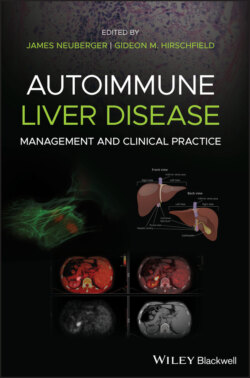Читать книгу Autoimmune Liver Disease - Группа авторов - Страница 44
Role of Innate and Adaptive Immunity in Autoimmunity in the Context of the Liver as an Immune Organ Overview
ОглавлениеThe evolutionarily ancient innate immune system provides immediate responses to pathogen‐associated molecular patterns(PAMPs) and damage‐associated molecular patterns (DAMPs) associated with microbes and injured or dying cells, respectively [3]. In contrast, the adaptive immune system responds to specific peptide antigens through antigen‐specific T‐cell responses and B‐cell production of antigen‐specific antibodies [4]. It is now clear that cytokines produced by an innate immune response dictate both the type and magnitude of adaptive responses and that both innate and adaptive immunity play important roles in the immunopathogenesis of all autoimmune diseases (Table 2.2 and Figure 2.2).
Table 2.1 Comparison of classic autoimmunity with AIH, PBC or PSC.
| Classic autoimmunity | AIH | PBC | PSC |
| Disease‐specific autoantigens | Yesa | Yes | Yesb |
| Disease‐specific autoantibodies | Yes, types 1 and 2 | Definite | Yes |
| Epitope determinant spreading | Unclear | No | Unclear |
| Female predilection | Yes | Yes | No |
| Occurrence in children and adults | Yes | No, adults only | Yes |
| Polygenetic predisposition | Yes | Yes | Yes |
| HLA immunogenetic associations | Yes | Yes | Yes |
| Non‐HLA genetic associations | Yes | Yes | Yes |
| Environmental triggers | Yes | Yes | Yes |
| Tissue/organ‐specific pathology | Yes | Yes | Yes |
| Associated extrahepatic autoimmune diseases | Yes | Yes | Yes |
| Associated IBD | Yes (weak) | No | Yes (strong) |
| Response to immunosuppression | Yes | Yes | No |
| Autoantigen‐specific animal models | Yes for type 2 No for type 1 | Yes | No |
a T and B cell epitopes defined in type 2, not type 1 AIH.
b β‐Tubulin isoform 5, not rigorously tested to determine prevalence, sensitivity or specificity.
AIH, autoimmune hepatitis; IBD, inflammatory bowel disease; PBC, primary biliary cholangitis; PSC, primary sclerosing cholangitis.
Innate immune inflammasome responses, especially those mediated by nucleotide‐binding oligomerization domain (NOD)‐like receptor P3 (NLRP3), occur in both innate immune cells and non‐immune cells, including hepatocytes, cholangiocytes, and hepatic stellate cells (HSCs) [5]. Thus, clinicians must embrace a new paradigm: cells or tissues are not passive “targets” of autoimmune diseases (including AILDs), but instead are active participants in the immunopathogenesis of their own injury and demise.
